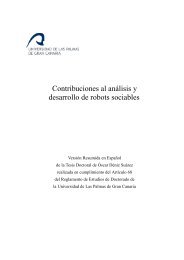PhD Document - Universidad de Las Palmas de Gran Canaria
PhD Document - Universidad de Las Palmas de Gran Canaria
PhD Document - Universidad de Las Palmas de Gran Canaria
You also want an ePaper? Increase the reach of your titles
YUMPU automatically turns print PDFs into web optimized ePapers that Google loves.
CHAPTER 1. INTRODUCTION<br />
and surprise. Feelix implements two mo<strong>de</strong>ls of emotional interaction and expression inspired<br />
by psychological theories about emotions in humans. Tactile sensations translate directly into<br />
emotions. This low perceptual bandwidth does not require attentional mechanisms, which<br />
would be necessary with more complex sensors such as vision.<br />
Advanced perception techniques are obviously necessary for successful interaction.<br />
SIG [Okuno et al., 2002] is a humanoid robot <strong>de</strong>signed as a test bed of integration of per-<br />
ceptual information to control a large number of <strong>de</strong>grees of freedom. The visual perceptual<br />
subsystem is in charge of a stereo vision system, each camera having 3 DOF. The most re-<br />
markable aspect of SIG is its sound localization ability. It uses a total of four microphones.<br />
The body is covered with an isolating material. Two of the microphones are placed insi<strong>de</strong><br />
and the other two outsi<strong>de</strong>. This allows the robot to cancel the noise of its own motors (see<br />
Section 5.2).<br />
The ability to talk to multiple users in the same session is addressed in ROBITA<br />
[Matsusaka et al., 1999]. This poses many problems, such as recognition of who is speaking<br />
and to whom he is speaking. To solve them, the robot implements face recognition, face<br />
direction recognition, sound localization, speech recognition and gestural output. It has 2<br />
CCD cameras on his head, 2 DOF for each of them and 2 DOF in the neck. The robot uses a<br />
total of 9 computers.<br />
The availability of hardware elements has led to a profusion of social robots. A<br />
big laboratory and group of researchers is no longer necessary to complete a complex robot.<br />
There is a clear -and positive- ten<strong>de</strong>ncy to fall into the I-want-to-build-one-too, do-it-yourself<br />
fever. Interestingly, I-want-to-build-one-too systems, <strong>de</strong>spite being simple in hardware and<br />
techniques, are comparable to more complex systems. That is, excessive or advanced hard-<br />
ware does not seem to have a crucial effect on the overall "quality" of the robot. Two out-<br />
standing robots built with low-cost components are ARYAN and SEGURITRON, see Chap-<br />
ter 4.<br />
1.2 Analysis<br />
The study of the available literature about social robots allows to extract a number fundamen-<br />
tal i<strong>de</strong>as. First, there seems to be a clear ten<strong>de</strong>ncy to use psychology, ethology and infant<br />
social <strong>de</strong>velopment studies as the main inspiration source. In fact, the <strong>de</strong>velopment of al-<br />
most all of the robots built for social interaction revolve around one or more human mo<strong>de</strong>ls.<br />
This is the case of Kismet, for example, the <strong>de</strong>sign of which is inspired by infant-caregiver<br />
relationships. Other robots have used concepts like scaffolding, autism, imitation, shared<br />
8










